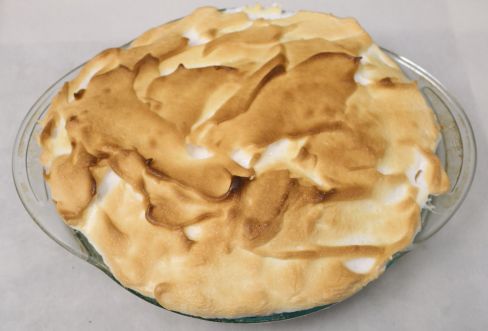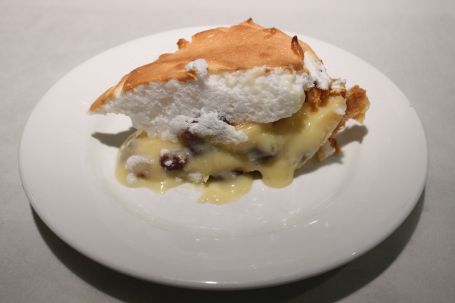Forum Replies Created
-
AuthorPosts
-
My wife orders a Caesar salad without dressing, because its romaine not iceberg lettuce or spring mix.
Not the prettiest pie I've made, I can never get those picture-perfect meringue peaks, but it is delicious!
The filling may have needed to be cooked a bit longer, it is a little soupy. But I'm willing to make the sacrifice to try it again. 🙂
Attachments:
You must be logged in to view attached files.I did make my banana cream pie, with raisins, using my wife's aunt's filling recipe (a pretty basic pastry cream IMHO), and a French meringue that was browned in the oven. It's chilling, I'll post pictures later on, hopefully including a slice. The scrapings from the pot on the pastry cream tasted pretty good.
I would think the time saved would pay for it pretty quickly, and the consistency of the product would probably go up, too. There's a restaurant near us that does about 100 pies a day, and around holidays and other special occasions several times that. I've not been in their kitchen but I would think they'd have to have something like this.
I'm going to do some kind of banana cream pie today, probably using the sour cream filling I used for the last sour cream raisin pie. It will probably have some cinnamon and raisins in it, too. And topped with French meringue.
As I understand it, 'taking challah' refers to setting aside a small amount of the dough as a sacrifice and applies to any type of bread, not just the eggy slightly sweet dough we all call challah. But that article doesn't explain that part very well, though I've read other articles that do.
So this is probably a case where the noun was appropriated from the verb.
I've seen those used at RibFest in Lincoln. When you have thousands of people eating messy ribs, you really need hand washing stations. Sadly, RibFest has been discontinued.
I've seen them make pizza crusts at Valentinos, they weigh out the crust, shape it into a ball, age it and then put it in a machine that turns out a perfectly round pizza crust. It can do different sizes by varying the amount of dough and there's a knob to control thickness so they can do thin crust pizzas with it, too.
I got a pie crust out of the freezer, not sure what kind of pie I'm making tomorrow yet.
There wasn't any toilet paper at the store when we went this evening, and not many loaves of bread either, though they still had hamburger and hot dog buns, and, it seemed, a lot of rye breads.
The ground beef area was emptied out, too, and I saw a lot of empty shelves in other areas, like dog food. But everything on our list was still available.
It won't be supper tonight, but I'm making a pot of chili. (It's best on day 2 anyway.)
We had French toast made from the Challah, with some really dark, nearly opaque, maple syrup.
My wife works with professors helping them with online instruction, she's going to be pretty busy the next few weeks. Nebraska has called off classes next week. The following week is spring break and then the rest of the semester will have all classes online.
When I went to the grocery store Tuesday, the checker was wearing surgical gloves.
I don't know enough about Jewish traditions to recognize mistakes, but I do notice some significant differences in ways various sites describe them, which may in part just be that they are relying upon different experts.
The Hamelman Challah recipe is pretty good, we gave away 2 of the 3 loaves to friends yesterday, they didn't notice much less mind the braiding issues.
-
AuthorPosts

